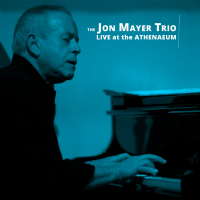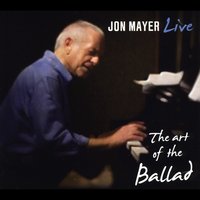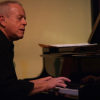Home » Jazz Musicians » Jon Mayer
Jon Mayer
Jon was born in New York City in 1938. There was a piano in the family apartment as his mother studied classical music and practiced as he went to sleep each night. He was exposed to jazz at an early age through recordings around the house of various big and small bands. Jon heard Charlie Parker play on a JATP (Jazz at the Philharmonic) concert recording and decided that Alto was his instrument. That lasted until the final year at the special music High School he attended. The piano became central in his life around then and his passion for the jazz being played around the city was all consuming.
The evolution continued after graduating from the famed High School of Music and Art in Manhattan(1956) and briefly attending the Manhattan School of Music. Mayer then became a regularly appearing member of the thriving NYC music scene playing with Kenny Dorham, Tony Scott, Pete LaRoca and Ray Draper. Eventually he recorded with two of the greatest saxophonists ever: Jackie McLean on Strange Blues (Prestige/OJC) and John Coltrane on a session known as the legendary "I Talk With The Trees" date and finally issued in 1990 as part of Coltrane’s Like Sonny (Roulette). He had a chance to hear, meet and play with some of the foremost musicians working in New York in this formative period. Among them were Jackie McLean, Kai Winding, John Coltrane, Freddy Hubbard, Kenny Dorham, Art Blakey, Lee Morgan, Art Taylor, Donald Byrd, Wayne Shorter, Elvin Jones, Bill Evans, Tony Scott, Booker Little, Milt Jackson, Max Roach, George Coleman, John Lewis, Jimmy Garrison and Paul Bley. He studied for brief periods with John Mehegan and Hall Overton.
1959 found Jon working in Paris at `Au Chat Qui Peche’ as part of a trio with Chuck Israels and Arnie Wise. It happened that the pianist he was working opposite was none other than Bud Powell. That summer included a night at the Blue Note with Chet Baker, Kenny Clarke and Pierre Michelot.
In the ‘60s and ‘70s, Mayer remained active, playing in both New York and Europe with the likes of the Thad Jones-Mel Lewis Jazz Orchestra, Dionne Warwick, Sarah Vaughan and the Manhattan Transfer, and writing songs recorded by Les McCann, Nancy Wilson and others.
Then due to numerous causes, he all but disappeared, entering a 13-year period of inactivity during which he rarely performed. But by 1991, Mayer was ready to return to music. He settled in Los Angeles and once again seriously pursued his career in the jazz world. People who heard him, initially with McCann’s Magic Band and as a leader, were readily impressed with his artistry, characterized by a supple and relaxed rhythmic feel and a keen sense of melodicism in his solos. Here was an authentic jazz musician, an artist who desired, as did Charlie Parker when stating his own personal goal, to play fast and clean and go for the pretty notes.
Read moreTags
Mark Winkler: Late Bloomin' Jazzman

by Edward Blanco
Veteran singer, platinum-selling lyricist and songwriter Mark Winkler delivers his twentieth album as leader, Late Bloomin' Jazzman, beginning with a George Gershwin standard, ending with a Gershwin tribute and, in between, presenting romantic ballads, a bit of swing and a touch of bossa. An educator at UCLA who teaches the art of songwriting, Winkler brings this remarkable talent to the fore on this album, providing his own lyrics to seven of the twelve songs which he suddenly realized “talk about ...
Continue ReadingMark Winkler: Late Bloomin' Jazzman

by Richard J Salvucci
Anyone who can hold their own on a stage on in a studio with Cheryl Bentyne cannot be all bad, right? Even if one's taste runs more to Harry Connick, Jr than to Mark Murphy, it is difficult not to get seriously into Mark Winkler. Oh, he can sing, for sure, but even if he could not carry a tune, he is a lyricist for the ages. Not all ages, mind you. But for those of a certain age, sensibility, ...
Continue ReadingWill Lyle: L.A. Source Codes

by Kyle Simpler
For computer programmers, a source code is a piece of computer language, which they are able to read and transfer and put to use in a practical way. With his debut album, L.A. Source Codes, bassist Will Lyle makes a connection between this concept and jazz. As with computer programming, jazz has its own language, and learning the language of jazz can be somewhat challenging. A skilled player, however, can take musical “source codes," such as chords, scales and arpeggios, ...
Continue ReadingJon Mayer: Live at the Athenaeum

by C. Michael Bailey
Pianist Jon Mayer has been quietly building his considerable discography over the last 25 years. Live at the Athenaeum joins eight previous releases that include, Full Circle (Reservoir Music, 2002); So Many Stars (Reservoir Music, 2007); Nightscape (Reservoir Music, 2009); and The Art of the Ballad (UDJ, 2014). These releases more than solidify Mayer's bona fides as an inventive composer and interpreter. Recorded at the Athenaeum in La Jolla, CA, Live at the Athenaeum proves a ballad-lover's delight ...
Continue ReadingJon Mayer: The Art of the Ballad

by C. Michael Bailey
Jon Mayer not John Mayer. This particular Mayer is a jazz pianist currently living on the West Coast who has been plying his Jazz trade in one form or another since the mid-1950s. Early on, Mayer played on two notable sessions: alto saxophonist Jackie McLean's Strange Blues (Prestige, 1957) and on the John Coltrane sessions recorded between 1958 and 1960 that eventually became Like Sonny (Roulette, 1990). Mayer did a stretch in Paris in the late '50s where he periodically ...
Continue ReadingJon Mayer: Nightscape

by Ken Dryden
Jon Mayer was working professionally as a jazz pianist as a teen back in the '50s, while attending the Manhattan School of Music. As well as working as a sideman with Tony Scott, Kenny Dorham, Chet Baker, the Thad Jones/Mel Lewis Orchestra, Sarah Vaughan and others, along with taking part in record dates with John Coltrane and Jackie McLean, Mayer contributed original pop songs to a number of vocalist record dates, though he did not make his recording debut as ...
Continue ReadingJon Mayer: Nightscape

by Bruce Lindsay
New York-born, Los Angeles-based pianist Jon Mayer began his musical career in the New York jazz scene of the 1950s and 1960s. He has a long and distinguished pedigree, including work with Jackie McLean and John Coltrane, but his first recording as leader came as late as 1996, with Round Up The Usual Suspects (Pullen Music). Nightscape is Mayer's eighth album as leader and it's an engaging, beautifully performed, collection of tunes. As with Mayer's previous albums ...
Continue ReadingThe craft of the jazz piano trio is a challenging one; and in a sea of fine trio recordings, it is hard to come by a performance that is just not merely good, as most are, but sublime. When one comes along; it is time to be excited, and So Many Stars is the one to be excited about. What are the ingredients of the perfect jazz piano trio recording? One is competent leadership, in this case pianist Jon Mayer, whose previous recordings��"My Romance (Reservoir Music, 2005), The Classics (Reservoir Music, 2004), Full Circle (Reservoir Music, 2002), and Rip Van Winkle (Blue Moon, 2000)��"have all been well-received
Primary Instrument
Piano
Willing to teach
Beginner to advanced
Music
Forasteira
From: L.A. Source CodesBy Jon Mayer





















